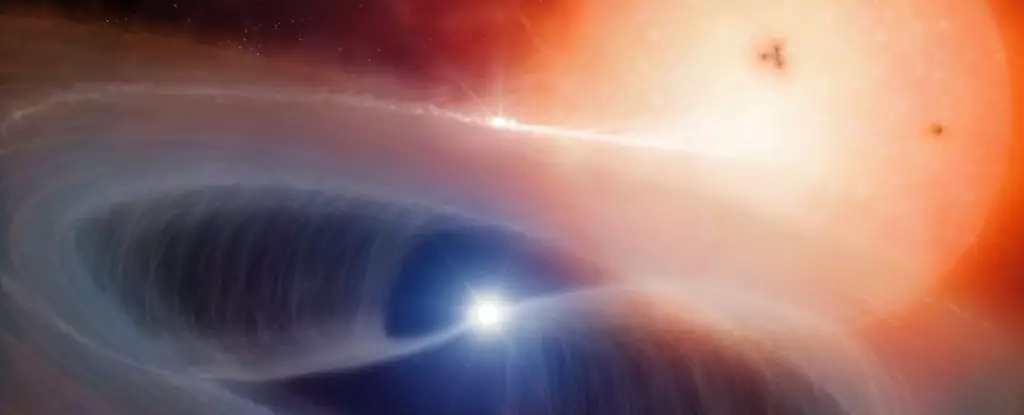The mystery of metal formation in the universe has puzzled astronomers for decades. While it is widely accepted that these elements are concocted in the fiery cores of astronomical events, identifying the specific origins and processes remains a complex challenge. Recent advancements in observational astronomy have illuminated the role of Type Ic supernovae, revealing that these explosive events are often the result of less massive stars in binary systems rather than the solitary supergiants once thought to be their progenitors.
The evolution of massive stars is intricately tied to their metallicity—the abundance of elements heavier than helium. Understanding this relationship is crucial as it influences the stars’ life cycles and end-of-life explosions. Traditionally, Type Ic supernovae were presumed to arise from stars significantly larger than our Sun, often dubbed ‘massive lone wolves.’ However, recent findings from an international team of astronomers, including Martín Solar and Michał Michałowski from Adam Mickiewicz University, highlight the significant impact of binary interactions in shaping these stellar explosions.
“Every new insight into massive stars reveals a deeper complexity,” Michałowski remarked, reflecting the evolving nature of our understanding. It appears that the intricate dance of stars in binary systems plays a pivotal role in their fates, suggesting that smaller stars—sometimes much less heavy than initially suspected—partner with a companion star to influence the conditions required for a Type Ic supernova.
Type Ic supernovae occur when massive stars reach an advanced stage in their life cycles, exhausting their fuel and lacking hydrogen and helium in their outer shells. As these stars collapse, they create incredibly dense remnants—neutron stars or black holes—while ejecting the outer material violently into space. This ejection process is fundamental to the creation of heavy elements; however, the absence of lighter elements like hydrogen and helium in their remnants presents an ongoing enigma.
Two primary hypotheses have historically been proposed to resolve this mystery: the first suggests that supermassive stars may lose their lighter elements through powerful stellar winds, while the second posits that a binary companion siphons these elements away before the supernova occurs. The latter scenario has gained traction based on new models, asserting that the majority of Type Ic progenitors are actually moderate-mass stars engaging in interactions with a companion star.
Researchers analyzed archival data from a comprehensive observational program called PHANGS (Physics at High Angular resolution in Nearby GalaxieS). By utilizing instruments like the Atacama Large Millimeter Array, they examined molecular gas clouds in proximity to supernova sites. The presence and concentration of molecular hydrogen in these regions can provide a clear indication of a progenitor star’s mass.
In contrasting the remnants of Type Ic and Type II supernovae, which has more well-established progenitor mass ranges, it was revealed that the molecular hydrogen concentrations were similar. This evidence challenges the earlier belief that Type Ic progenitors are consistently more massive. Instead, it suggests a surprising trend wherein a substantial fraction of these supernovae may arise from stars less daunting in scale than the initial hypotheses suggested.
The implications of these findings extend beyond merely classifying supernovae. The binary companion plays a crucial role in the evolutionary narrative of the progenitor stars, often enduring the cataclysmic explosion while being flung into a new trajectory across the cosmos. These remnants provide essential insights into the life cycles of stars in binary systems and their contributions to the overall chemical enrichment of the universe.
Michałowski theorizes that the enhanced carbon output generated through binary supernova events allows us to reevaluate our understanding of cosmic element distribution. Specifically, many life-essential elements, like carbon, may have originated from the explosions of Type Ic supernovae, necessitating modifications in our perceptions of cosmic element abundance.
The researchers aim to expand their astroforensic analyses to include a greater variety of supernovae, which would enable a deeper understanding of the complex processes governing stellar evolution. New observations will shed light on whether certain characteristics—like broad emission lines or galactic influences—correlate with specific details of the progenitor stars, thus enhancing our galaxy’s narrative.
As astronomers pursue this tantalizing trail of cosmic history, understanding the delicate balance of binary interactions will be paramount in unraveling how metals are forged in the cosmos. This endeavor not only enriches our comprehension of the universe’s fabric but also underscores the elegant complexity inherent in the lives of stars—powerful, fleeting, and interconnected in ways we are only beginning to appreciate.

